Psoriatic Arthritis Remission
Psoriatic arthritis can have many different symptoms – and they can all be different in each person who has this disease. Clinical remission is a more recent concept in PsA than other types of arthritis, like RA. Generally, your rheumatologist can determine that you are in remission when you no longer show any of the main signs of active disease:
- Peripheralarthritis (all the joints except the spine)
- Nail or skin psoriasis (such as pitting or plaques)
- Spondylitis (back or neck arthritis)
- Enthesitis (inflammation of the tissues at joint connections)
- Dactylitis (“sausage” or swollen fingers and toes)
Your doctor can examine your body and determine your disease activity level. There is no one “correct” tool to say you’re in remission or you’re not there yet. Your doctor’s or nurse’s judgment always comes first.
Your rheumatologist or dermatologist can use standard tests and scores to tell if your PsA is in remission.
These include:
- Number of tender and swollen joints
- Your own assessment of joint pain
- How much morning stiffness you have
- Physician and patient global assessment of arthritis (VAS)
- Erythrocyte sedimentation rate (ESR) in your blood
- C-reactive protein (CRP) in your blood
- A psoriasis area and severity index (PASI) score
There are also tests to measure your levels of skin psoriasis, including the amount of erythema (swelling), induration (thickness), and the extent or scale of your skin outbreaks (BSA). Your doctor can also use standard tests to measure your enthesitis and dactylitis severity. By adding up these test results and scores, your doctor can make a solid assessment that your disease activity is low or even in remission.
A recent study called Tight Control of In ammation in Early Psoriatic Arthritis (TICOPA) showed some promise for a “treat-to-target” strategy in PsA, an approach also called “tight control.” In this approach, methotrexate dose was increased to up to 25mg after six weeks. Disease activity was measured, such as the number of tender or swollen joints. It was followed using MDA (minimal disease activity) which also includes patient reported outcome, skin involvement and presence of enthesitis. After 12 weeks, if disease activity goals were not met, other DMARDs were added in combination with methotrexate. After four months, more patients in the “tight control” group in the study had met disease activity goals than those patients who received the standard treatment approach.
What does all this mean? Research is ongoing to develop, refine, and confirm treatment approaches that work well in a majority of PsA patients – and that may help you achieve your goal of remission too. The idea behind “treat-to-target” is that your rheumatologist can aggressively treat your disease to reach a specific goal: lower disease activity.
Remember: Just because you feel great and can do tasks you couldn’t do before you started your treatments — like wash the car or weed the garden — doesn’t mean that your inflammation isn’t still a problem. Your PsA could still be there at a lower level.
Some people with PsA can more realistically aim for and reach low disease activity levels or “near-remission.” Some people with PsA have more severe skin disease, while others may have fewer skin problems and more inflammation in their joints and other organs. You need to work with your doctors—both your rheumatologist and your dermatologist if you see both to manage your disease—to treat your PsA until your symptoms ease and your disease activity is lowered. For some people, skin psoriasis may be so widespread over their body and painful that it really harms their quality of life. For others, it may be local or mild, and your doctor may be more concerned about inflammation that harms your joints, eyes, or other organs.
It is important to achieve a good quality of life with PsA even if you are never able to reach “remission.” There are many issues related to taking drugs that lower inflammation. They include cost, side effects, possibly delaying pregnancy, and convenience if you need to get infusions or shots in a doctor’s office. You and your doctors can discuss whether or not you need to treat your PsA until you reach remission, or if you can just treat your disease until it is less active and your symptoms are manageable.
What happens when you reach remission?
Because remission is not well defined in psoriatic arthritis, it is not really known if you can stop taking your drugs, or cut back on how many or how much you take.
If you do reach remission, your doctor might be able to taper your medication dosage down to a smaller level or even take you off your PsA treatment altogether. “Tapering” means you slowly cut down on your therapy one medication at a time (reducing dose or dosing frequency). There has been some evidence that people with PsA who reach remission and stop taking their drugs do not have any negative effects, but other studies show that you can be more likely to have a relapse.
Tapering could have some benefits. You may not have to take as many pills or shots or infusions as you once did. You may not have to fill as many prescriptions or deal with as many drug co-pays. You may not have as many side effects from your treatments, because your dosages are lower.
Many people will not able to stop taking psoriatic arthritis drugs altogether. Because if you do, your inflammation could come back. And as you taper your treatments, your doctor will watch your disease activity to make sure the new approach is working for you.
Any decision about your treatment plan once you’re in remission should be made with your values and preferences in mind. You and your doctor should have a conversation to go over all of your options so you can try to stay in remission and cut down on your risk of a flare.
The information in these guidelines should never replace the information and advice from your treating physician. It is meant to inform the discussion that you have with healthcare professionals, as well as others who play a role in your care and well being.





